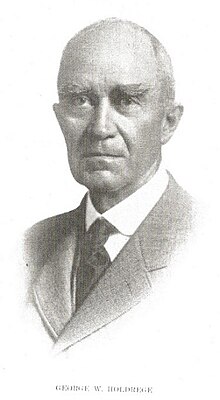
Scouting in Nebraska has a long history, from the 1910s to the present day, serving thousands of youth in programs that suit the environment in which they live.

Holdrege is a city in Phelps County, Nebraska, United States. The population was 5,495 at the 2010 census. It is the county seat of Phelps County. The Nebraska Prairie Museum is located in Holdrege.

Gilbert Stanley Underwood was an American architect best known for his National Park lodges.
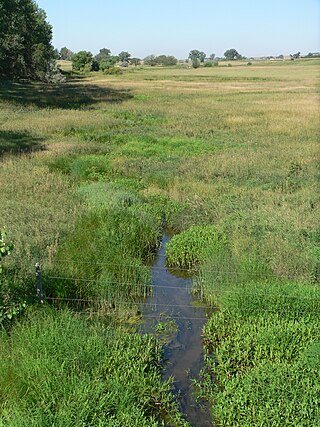
Lodgepole Creek is a tributary of the South Platte River, approximately 278 miles (447 km) long, in the U.S. states of Wyoming, Nebraska and Colorado. Lodgepole Creek drains a basin in the interior of a low plateau which lies between the South Platte Basin and the North Platte Basin in the southeastern corner of Wyoming, the southern edge of the Nebraska Panhandle and several small portions of northeastern Colorado. As its name implies, Lodgepole Creek is a very small stream; for nearly all of its length it flows through the semiarid High Plains. The Lodgepole Creek Valley has been a major transportation route for over 100 years; the line of the original transcontinental railroad, the Lincoln Highway/U.S. Highway 30 and Interstate 80 all run along the stream for much of its length.
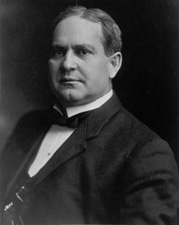
Norris Brown was a Senator from Nebraska.

Thomas Rogers Kimball was an American architect in Omaha, Nebraska. An architect-in-chief of the Trans-Mississippi Exposition in Omaha in 1898, he served as national President of the American Institute of Architects from 1918 to 1920 and from 1919 to 1932 served on the Nebraska State Capitol Commission.
A private in the Fourth Infantry, Charles Howard served as photographer for the Stanton Expedition in 1877, traveling throughout eastern Wyoming, western Nebraska and into the Black Hills of Dakota Territory.
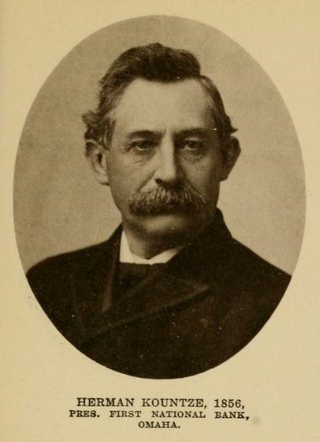
Herman Kountze was a powerful and influential pioneer banker in Omaha, Nebraska, during the late 19th century. After organizing the Kountze Brothers Bank in 1857 as the second bank in Omaha, Herman and his brothers Augustus, Charles and Luther changed the charter in 1863, opening the First National Bank of Omaha that year. Kountze was involved in a number of influential ventures around Omaha, including the development of the Omaha Stockyards and the Trans-Mississippi and International Exposition of 1898. Immediately after his death Kountze was regarded as one of Omaha's "old settlers". Today Kountze's First National Bank is the oldest bank west of the Mississippi River, and continues as a privately held company in its sixth generation of family ownership.
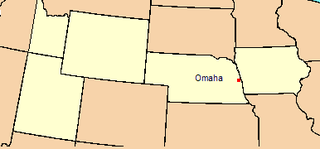
The Department of the Platte was a military administrative district established by the U.S. Army on March 5, 1866, with boundaries encompassing Iowa, Nebraska, Dakota Territory, Utah Territory and a small portion of Idaho. With headquarters in Omaha, the district commander oversaw the army's role initially along the Overland route to Salt Lake City, then later the construction route of the Union Pacific Railroad. The district also included the Montana road through eastern Wyoming. The district was discontinued when the Army's command was reorganized in 1898.
Daniel Sedgley Mitchell (1838-1929) was an American photographer best known for his series of stereoscopic views of the Black Hills in 1876, his Native American portraits from the Red Cloud Agency in 1877, and his photographs of the Oklahoma Land Rush in 1889.

Gurdon Wallace Wattles was an early businessman, banker, and civic leader in Omaha, Nebraska, who became responsible for bankrolling much of early Hollywood. Wattles was said to possess "all the right credentials to direct Omaha's fortunes for the twentieth century in the post-pioneer era: humble beginnings, outstanding ability, a fine intellect, impeccable manners, driving ambition, and a ruthless streak."

The Sheridan Inn is a historic hotel in Sheridan, Wyoming. Designed by the architect Thomas R. Kimball of Omaha, Nebraska in 1893, it was constructed by the Chicago, Burlington, and Quincy Railroad as part of its development program in Wyoming associated with extension of the railway. Equipped with the first bathtubs and electric lights in that part of Wyoming, the inn was considered the "finest hotel" between Chicago and San Francisco. It was declared a National Historic Landmark in 1964.

John William Rawlings[Red] was an American second baseman and shortstop in Major League Baseball who played for six different teams between the 1914 and 1926 seasons. Listed at 5 ft 8 in (1.73 m), 158 lb., he batted and threw right-handed.
Significant events in the history of Omaha, Nebraska, include social, political, cultural, and economic activities.

William F. Gernandt was a German-born architect who was based in Nebraska. He designed a number of courthouses and other buildings that are listed on the National Register of Historic Places.
Joy Theodore John Berquist, sometimes known as "Teddie" Berquist, and known professionally as J. T. Berquist, was an American football player, lawyer, and judge. He played college football for Nebraska and in the National Football League (NFL) for the Kansas City Blues/Cowboys and Chicago Cardinals (1927).

Thomas Lord Kimball was an American railroad executive. Born in Buxton, Maine, he worked various jobs before becoming an agent of the Pennsylvania Railroad Company in 1860. He was appointed to various positions in the company, before moving to Omaha, Nebraska, in 1871 to work for Union Pacific. From there, he climbed the ranks, eventually being promoted to the position of vice-president. Kimball retired in 1897 and died in 1899.
African Americans in Nebraska or Black Nebraskans are residents of the state of Nebraska who are of African American ancestry. With history in Nebraska from the Lewis and Clark Expedition through the Civil War, emancipation, the Reconstruction era, resurgence of white supremacy with the Ku Klux Klan and Jim Crow Laws, the Civil Right movement, into current times, African Americans have contributed vastly to the economics, culture, and substance of the state.
